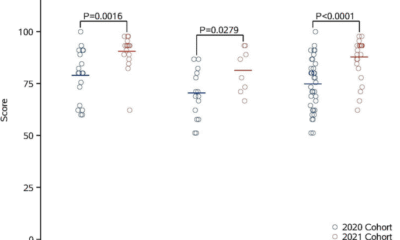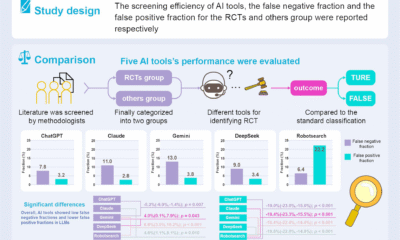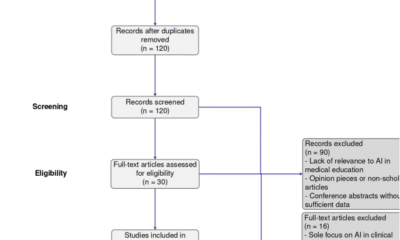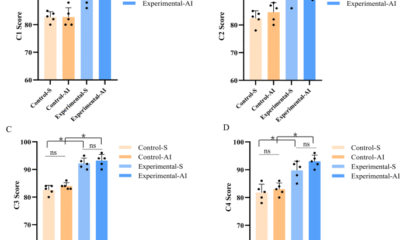AI Research
Application and ethical implication of generative artificial intelligence in medical education: a cross-sectional study among critical care academic physicians in China | BMC Medical Education
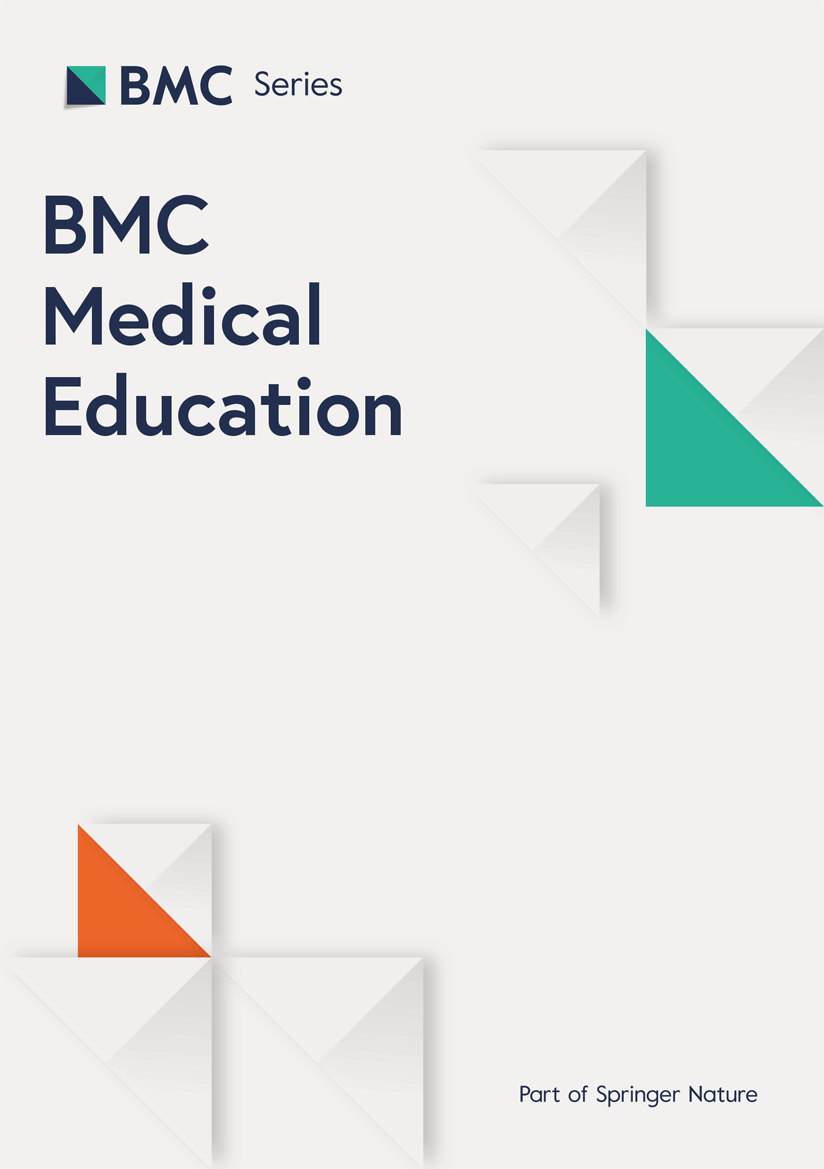
This study investigated the understanding, utilization, and ethical awareness of the GAI among Chinese critical care academic physicians involved in standardized residency training. By examining the current application of the rapidly evolving GAI in critical care medical education, this study highlights both the advantages and limitations of GAI in medical education, underscores the urgency of GAI training, and fills a significant gap in the field.
Understanding, usage, and attitudes toward GAI
The study revealed that 64.7% of surveyed critical care academic physicians in China utilized GAI, indicating its initial level of adoption. Academic physicians who use GAI have a positive attitude towards its potential to enhance clinical skills, indicating GAI’s potential to assist in medical decision-making and knowledge acquisition. Therefore, providing application training on GAI usage for critical care academic physicians who have not yet mastered it may further enhance their clinical capabilities with the assistance of GAI. However, challenges such as a lack of experience with GAI and insufficient quality of generated content persist. These issues can also be mitigated through GAI usage training, and continuous upgrades to GAI models can further alleviate these difficulties.
Usage and attitudes of GAI in medical education
The study results indicated that only a small proportion of the surveyed critical care academic physicians had experience using GAI in medical education. This underscores the need for training that integrates the GAI into medical education.
The regression analysis of the results indicated that critical care academic physicians who used GAI in clinical medical work were also more likely to use GAI in TA-SRT. In contrast, participation in GAI training did not significantly influence its use.
The ‘AI-integrated’ paradigm proposed by Xu et al. [14] suggests that physicians exposed to AI-enhanced clinical workflows are more likely to adopt these tools in teaching, aligning with our results.
Therefore, leveraging practical experience with GAI in clinical settings as an entry point to increase usage and subsequently extending its application to medical educational scenarios may be a feasible approach to enhance the utilization of GAI in medical education, although it is not the sole pathway.
Physicians in the GAI-User group were typically younger and predominantly attending physicians, reflecting a greater enthusiasm for GAI among younger doctors. This trend highlights the leading role played by young and middle-aged physicians in adopting new technologies in critical care medicine in China.
The regression analysis of the results in this section indicates that critical care academic physicians who use GAI in clinical medical work are also more likely to use GAI in the TA-SRT. In contrast, participation in GAI training does not significantly influence its use. Therefore, leveraging practical experience with GAI in clinical settings as an entry point to increase its usage and subsequently extend its application to medical educational scenarios may be a practical approach for enhancing the utilization of GAI in medical education.
Applications and limitations of GAI in medical education
The results suggest that GAI’s current application of GAI in medical education is mainly focused on the rapid acquisition of educational resources and the efficient preparation of teaching materials, which are closely related to its strengths in information processing and content generation [9]. Hallquist et al. reported that GPT-4 generated 56% ‘A-grade’ illness scripts and 84% accurate Multiple-Choice Questions [13], corroborating our finding that GAI is primarily leveraged for rapid retrieval of educational resources.
Meanwhile, the survey results indicated positive feedback on the GAI in the GAI-User group, suggesting that academic physicians view it as an effective tool for enhancing their teaching capabilities and efficiency. The GAI can alleviate the burden of educational tasks while improving the quality of teaching content. In the exploration of future medical education reforms, utilizing GAI to achieve personalized learning plans, individualized teaching feedback, and promoting fairness in education may be key areas where GAI can enhance medical education [1, 16].
However, feedback regarding the poor quality and instability of the generated content highlights the challenges that GAI faces in the practice of medical education. Continuous advancement of the GAI model and ongoing training in its use may hold the key to solving this problem, as well-constructed prompts can significantly improve the quality of the GAI output [19].
Ethical issues in the application of GAI in medical education
The application of GAI in medical education is increasingly associated with various potential ethical issues [12, 20,21,22,23,24]. For instance, the unauthorized use of proprietary examination content by GAI tools raises intellectual property concerns, reinforcing the call for institutional governance frameworks [25]. Previous studies [15], including surveys conducted among medical students in Europe, have highlighted the lack of formal education on GAI and its ethics within medical curricula.
The results of our survey revealed that only 50.4% of the surveyed physicians were aware of the potential ethical issues that GAI might introduce into medical education. The primary ethical concerns identified by the respondents regarding the use of GAI in medical education include the potential decline in cognitive and judgment abilities due to over-reliance on GAI as well as data privacy issues associated with the information provided to GAI.
These findings suggest that the ethical awareness of GAI is primarily linked to knowledge proficiency rather than practical application experience (Table S3). Thus, there is a need for specialized training on the ethical issues surrounding GAI. This is the current consensus among critical care academic physicians. Most surveyed physicians believed that ethical considerations related to GAI should be incorporated into GAI education curricula.
Thus, the results of this survey and a previous study [26] suggest that academic physicians need as much GAI ethics training as residents, especially older physicians. This provides a basis for incorporating GAI training into physicians’ continuing medical education.
Policy and implementation recommendations
The findings of this study can inform the rationale for applying GAI and its sustainable integration into teaching activities. First, training programs should leverage physicians’ existing clinical GAI experience as a foundational module for translating usage into teaching applications. Second, given that only 50.4% of respondents demonstrated clear awareness of GAI-related ethical issues, while 94.3% strongly advocated for relevant guidance, training institutions should mandate ethics courses covering critical concerns such as over-reliance and data privacy as compulsory components. To bridge the significant disparities in GAI understanding and practical experience across regions in China, we recommend establishing nationally accessible training platforms with standardized curricula to ensure equitable resource distribution. Teams with extensive experience in using GAI in clinical teaching activities could pilot GAI-driven teaching and assessment tools in standardized residency training, along with rigorous validation studies.
Through these measures, the application of GAI in critical care clinical teaching activities might be implemented under secure information practices and appropriate ethical frameworks, ultimately advancing the overall teaching quality. This structured approach balances practical skill development with ethical governance, and facilitates the responsible and sustainable integration of GAI.
Limitations
This study has some limitations: (1) In China, there are significant disparities in the development and teaching standards of critical care medicine across different regions. The participants in this study were primarily concentrated in the eastern provinces, which may have led to discrepancies between the sample and the overall population. (2) Online surveys may introduce selection bias, as critical care physicians familiar with GAI are more likely to participate. (3) Although this study accounted for certain potential confounding factors, other unexamined confounding variables may have existed. (4) Owing to the self-reported nature of the data, responses could be subject to biases stemming from memory lapses, misunderstanding of questions, or a propensity to give socially acceptable answers. (5) Physicians of different titles were grouped as GAI User/Non-user because (1) regression analyses showed no association between professional title and GAI usage (Table S2), (2) their teaching activities were functionally comparable, and (3) subdivision by title was precluded by insufficient subgroup sizes (e.g., n = 33 Chief Physicians). This limits the title-specific inferences.
AI Research
Lessons from 60 Years in Journalism — A Postscript on Artificial Intelligence – TAPinto
AI Research
Tories pledge to get ‘all our oil and gas out of the North Sea’

Conservative leader Kemi Badenoch has said her party will remove all net zero requirements on oil and gas companies drilling in the North Sea if elected.
Badenoch is to formally announce the plan to focus solely on “maximising extraction” and to get “all our oil and gas out of the North Sea” in a speech in Aberdeen on Tuesday.
Reform UK has said it wants more fossil fuels extracted from the North Sea.
The Labour government has committed to banning new exploration licences. A spokesperson said a “fair and orderly transition” away from oil and gas would “drive growth”.
Exploring new fields would “not take a penny off bills” or improve energy security and would “only accelerate the worsening climate crisis”, the government spokesperson warned.
Badenoch signalled a significant change in Conservative climate policy when she announced earlier this year that reaching net zero would be “impossible” by 2050.
Successive UK governments have pledged to reach the target by 2050 and it was written into law by Theresa May in 2019. It means the UK must cut carbon emissions until it removes as much as it produces, in line with the 2015 Paris Climate Agreement.
Now Badenoch has said that requirements to work towards net zero are a burden on oil and gas producers in the North Sea which are damaging the economy and which she would remove.
The Tory leader said a Conservative government would scrap the need to reduce emissions or to work on technologies such as carbon storage.
Badenoch said it was “absurd” the UK was leaving “vital resources untapped” while “neighbours like Norway extracted them from the same sea bed”.
In 2023, then Prime Minister Rishi Sunak granted 100 new licences to drill in the North Sea which he said at the time was “entirely consistent” with net zero commitments.
Reform UK has said it will abolish the push for net zero if elected.
The current government said it had made the “biggest ever investment in offshore wind and three first of a kind carbon capture and storage clusters”.
Carbon capture and storage facilities aim to prevent carbon dioxide (CO2) produced from industrial processes and power stations from being released into the atmosphere.
Most of the CO2 produced is captured, transported and then stored deep underground.
It is seen by the likes of the International Energy Agency and the Climate Change Committee as a key element in meeting targets to cut the greenhouse gases driving dangerous climate change.
AI Research
Dogs and drones join forest battle against eight-toothed beetle

Esme Stallard and Justin RowlattClimate and science team
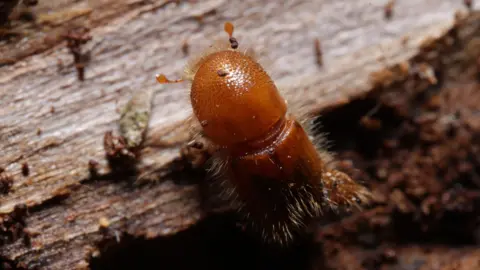 Sean Gallup/Getty Images
Sean Gallup/Getty ImagesIt is smaller than your fingernail, but this hairy beetle is one of the biggest single threats to the UK’s forests.
The bark beetle has been the scourge of Europe, killing millions of spruce trees, yet the government thought it could halt its spread to the UK by checking imported wood products at ports.
But this was not their entry route of choice – they were being carried on winds straight over the English Channel.
Now, UK government scientists have been fighting back, with an unusual arsenal including sniffer dogs, drones and nuclear waste models.
They claim the UK has eradicated the beetle from at risk areas in the east and south east. But climate change could make the job even harder in the future.
The spruce bark beetle, or Ips typographus, has been munching its way through the conifer trees of Europe for decades, leaving behind a trail of destruction.
The beetles rear and feed their young under the bark of spruce trees in complex webs of interweaving tunnels called galleries.
When trees are infested with a few thousand beetles they can cope, using resin to flush the beetles out.
But for a stressed tree its natural defences are reduced and the beetles start to multiply.
“Their populations can build to a point where they can overcome the tree defences – there are millions, billions of beetles,” explained Dr Max Blake, head of tree health at the UK government-funded Forestry Research.
“There are so many the tree cannot deal with them, particularly when it is dry, they don’t have the resin pressure to flush the galleries.”
Since the beetle took hold in Norway over a decade ago it has been able to wipe out 100 million cubic metres of spruce, according to Rothamsted Research.
‘Public enemy number one’
As Sitka spruce is the main tree used for timber in the UK, Dr Blake and his colleagues watched developments on continental Europe with some serious concern.
“We have 725,000 hectares of spruce alone, if this beetle was allowed to get hold of that, the destructive potential means a vast amount of that is at risk,” said Andrea Deol at Forestry Research. “We valued it – and it’s a partial valuation at £2.9bn per year in Great Britain.”
There are more than 1,400 pests and diseases on the government’s plant health risk register, but Ips has been labelled “public enemy number one”.
The number of those diseases has been accelerating, according to Nick Phillips at charity The Woodland Trust.
“Predominantly, the reason for that is global trade, we’re importing wood products, trees for planting, which does sometimes bring ‘hitchhikers’ in terms of pests and disease,” he said.
Forestry Research had been working with border control for years to check such products for Ips, but in 2018 made a shocking discovery in a wood in Kent.
“We found a breeding population that had been there for a few years,” explained Ms Deol.
“Later we started to pick up larger volumes of beetles in [our] traps which seemed to suggest they were arriving by other means. All of the research we have done now has indicated they are being blown over from the continent on the wind,” she added.
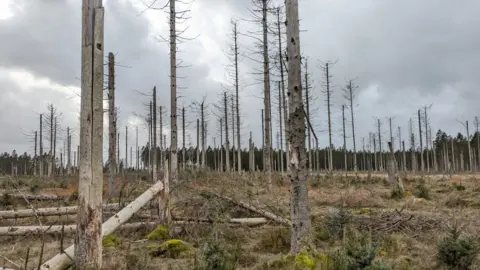 Daegan Inward/Forestry Research
Daegan Inward/Forestry ResearchThe team knew they had to act quickly and has been deploying a mixture of techniques that wouldn’t look out of place in a military operation.
Drones are sent up to survey hundreds of hectares of forest, looking for signs of infestation from the sky – as the beetle takes hold, the upper canopy of the tree cannot be fed nutrients and water, and begins to die off.
But next is the painstaking work of entomologists going on foot to inspect the trees themselves.
“They are looking for a needle in a haystack, sometimes looking for single beetles – to get hold of the pioneer species before they are allowed to establish,” Andrea Deol said.
In a single year her team have inspected 4,500 hectares of spruce on the public estate – just shy of 7,000 football pitches.
Such physically-demanding work is difficult to sustain and the team has been looking for some assistance from the natural and tech world alike.
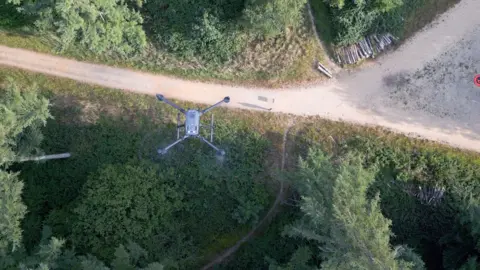 Tony Jolliffe/BBC
Tony Jolliffe/BBCWhen the pioneer Spruce bark beetles find a suitable host tree they release pheromones – chemical signals to attract fellow beetles and establish a colony.
But it is this strong smell, as well as the smell associated with their insect poo – frass – that makes them ideal to be found by sniffer dogs.
Early trials so far have been successful. The dogs are particularly useful for inspecting large timber stacks which can be difficult to inspect visually.
The team is also deploying cameras on their bug traps, which are now able to scan daily for the beetles and identify them in real time.
“We have [created] our own algorithm to identify the insects. We have taken about 20,000 images of Ips, other beetles and debris, which have been formally identified by entomologists, and fed it into the model,” said Dr Blake.
Some of the traps can be in difficult to access areas and previously had only been checked every week by entomologists working on the ground.
The result of this work means that the UK has been confirmed as the first country to have eradicated Ips Typographus in its controlled areas, deemed to be at risk from infestation, and which covers the south east and east England.
“What we are doing is having a positive impact and it is vital that we continue to maintain that effort, if we let our guard down we know we have got those incursion risks year on year,” said Ms Deol.
 Tony Jolliffe/BBC
Tony Jolliffe/BBCAnd those risks are rising. Europe has seen populations of Ips increase as they take advantage of trees stressed by the changing climate.
Europe is experiencing more extreme rainfall in winter and milder temperatures meaning there is less freezing, leaving the trees in waterlogged conditions.
This coupled with drier summers leaves them stressed and susceptible to falling in stormy weather, and this is when Ips can take hold.
With larger populations in Europe the risk of Ips colonies being carried to the UK goes up.
The team at Forestry Research has been working hard to accurately predict when these incursions may occur.
“We have been doing modelling with colleagues at the University of Cambridge and the Met Office which have adapted a nuclear atmospheric dispersion model to Ips,” explained Dr Blake. “So, [the model] was originally used to look at nuclear fallout and where the winds take it, instead we are using the model to look at how far Ips goes.”
Nick Phillips at The Woodland Trust is strongly supportive of the government’s work but worries about the loss of ancient woodland – the oldest and most biologically-rich areas of forest.
Commercial spruce have long been planted next to such woods, and every time a tree hosting spruce beetle is found, it and neighbouring, sometimes ancient trees, have to be removed.
“We really want the government to maintain as much of the trees as they can, particularly the ones that aren’t affected, and then also when the trees are removed, supporting landowners to take steps to restore what’s there,” he said. “So that they’re given grants, for example, to be able to recover the woodland sites.”
The government has increased funding for woodlands in recent years but this has been focused on planting new trees.
“If we only have funding and support for the first few years of a tree’s life, but not for those woodlands that are 100 or century years old, then we’re not going to be able to deliver nature recovery and capture carbon,” he said.
Additional reporting Miho Tanaka

-
Tools & Platforms3 weeks ago
Building Trust in Military AI Starts with Opening the Black Box – War on the Rocks
-

 Ethics & Policy1 month ago
Ethics & Policy1 month agoSDAIA Supports Saudi Arabia’s Leadership in Shaping Global AI Ethics, Policy, and Research – وكالة الأنباء السعودية
-

 Events & Conferences3 months ago
Events & Conferences3 months agoJourney to 1000 models: Scaling Instagram’s recommendation system
-

 Jobs & Careers2 months ago
Jobs & Careers2 months agoMumbai-based Perplexity Alternative Has 60k+ Users Without Funding
-

 Business1 day ago
Business1 day agoThe Guardian view on Trump and the Fed: independence is no substitute for accountability | Editorial
-

 Funding & Business2 months ago
Funding & Business2 months agoKayak and Expedia race to build AI travel agents that turn social posts into itineraries
-

 Education2 months ago
Education2 months agoVEX Robotics launches AI-powered classroom robotics system
-

 Podcasts & Talks2 months ago
Podcasts & Talks2 months agoHappy 4th of July! 🎆 Made with Veo 3 in Gemini
-

 Podcasts & Talks2 months ago
Podcasts & Talks2 months agoOpenAI 🤝 @teamganassi
-

 Jobs & Careers2 months ago
Jobs & Careers2 months agoAstrophel Aerospace Raises ₹6.84 Crore to Build Reusable Launch Vehicle








